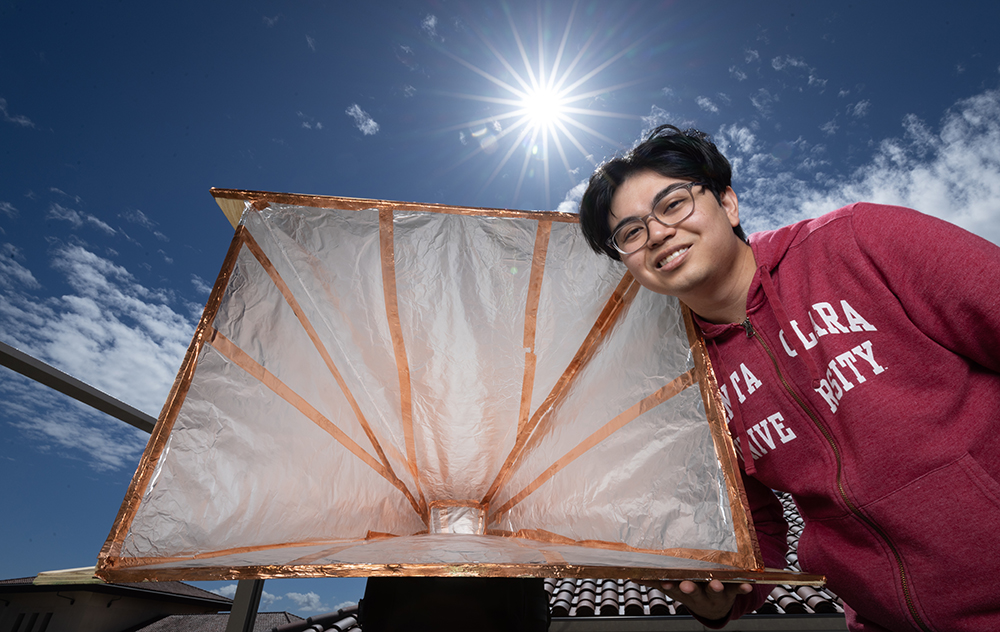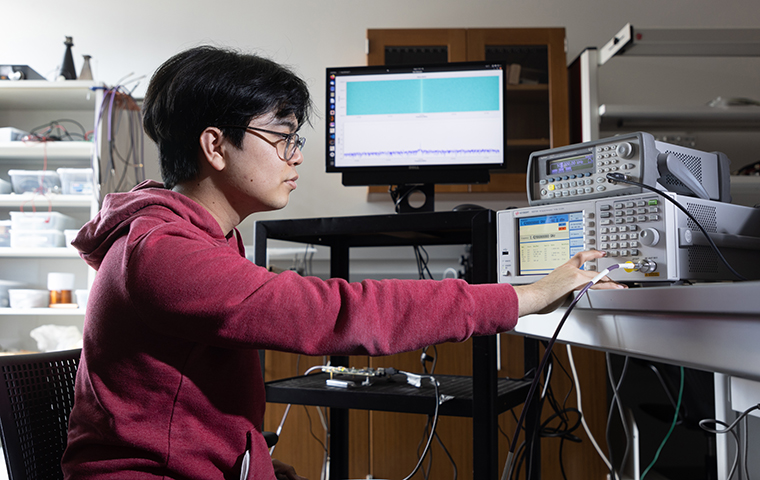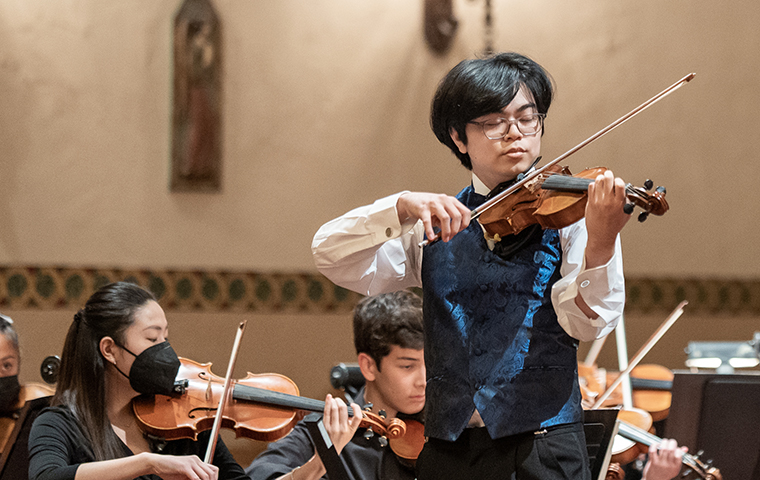
The Music of the Skies
With his senior design project, electrical engineering student (and sometimes violinist) Tyler Ikehara ’22 hopes to bring radio astronomy capabilities to Santa Clara University.
Life is about to change for Tyler Ikehara ’22, in a really exciting way. Three months from now, the senior will pack up his apartment in Santa Clara and move across the country to start his electrical engineering Ph.D. program at New York University.
On top of living in one of the biggest cities in the world, Ikehara will be doing cutting-edge research under professor and NYU Wireless director Thomas Marzetta, who originated Massive MIMO, one of the cornerstones of 5g technology.
“With him, I'll be studying physics-based breakthroughs that could potentially make for the next generation of wireless technology,” Ikehara says. “The program is big, but the lab seemed really similar to what it's like at Santa Clara. Everyone is trying to look out for each other. I just felt a lot of energy, both from the students and the city.”
Ikehara has already accomplished a lot at Santa Clara, but, before he leaves, he has one last thing to do. For his senior design project, Ikehara is working with a group of students to create a radio telescope which will allow students to study the movements of celestial bodies. The project is in its final testing but if successful, Ikehara hopes to pass it on to future students to improve upon his framework and perform research previously unavailable at SCU.
Recently, Ikehara sat down to talk about his senior project and other research opportunities he’s had in college.
When most people think about a telescope, they think of looking at stars or beautiful photos of outer space. But a radio telescope is a little different. For those who don’t know, what is a radio telescope?
If you look at many of the famous telescopes, like the James Webb telescope, they are mostly for optical images. A radio telescope is not actually trying to make a picture. Instead, it looks at the sky and takes in electromagnetic waves associated with celestial bodies and then uses Software Defined Radio (SDR) to process it so we can learn about where these bodies are in the galaxy, even if the signal is very faint. For example, our telescope is a horn antenna that searches for the known frequency of 1420 MHz, which is produced by hydrogen atoms. These hydrogen atoms are associated with certain celestial bodies, so if we detect a signal at that frequency, we can determine celestial bodies and their movements relative to us.

We’ve set it up so it can be a multi-stage project. Next year, another team can use our framework and make it better. For example, we used the horn antenna because it's relatively simple to construct, but it doesn’t always give the exact results you’d want. The next step could be redesigning the antenna and using a more directive parabolic dish antenna or a horn that can be moved.
How did you get involved in doing research outside of the classroom at Santa Clara?
My second year I took an electromagnetic course with Assistant Professor Kurt Schab, who is really awesome. He mentioned a project he was working on and it really intrigued me, so I asked if I could join his research group. My first project was over the summer of my sophomore year and it focused on Software Defined Radio, which is basically a reprogrammable antenna and radio device. Instead of having to swap out hardware to fit a certain application, you can reprogram the SDR through software. It's more flexible in that sense and can be used for lots of things—AM/FM radio, GPS, birdwatching, and various other radio applications. For this project, I spent a lot of time reading up on Software Defined Radios and was able to get some hardware—a small USB-dongle SDR, basically—to tinker with. I tried to get it to work with AM/FM radio and also tried to get it to work with ADSB to track planes. We’d meet with other students and Dr. Schab every other week to discuss what we’d learned. I spent most of the summer on it before shelving it for a bit to work on another project, but I came back to it and used my research to inform my senior design project.
You also did some research with the United States Navy. How did you get involved with that?
It was part of an internship with the branch of the Navy called the Naval Information Warfare Center Pacific (NIWC Pacific). I actually got involved with this, again, through Dr. Schab. because he was involved with the research, too. We tested High Frequency antennas to see if we could improve their efficiency and bandwidth past fundamental limits. We used a technique called Direct Antenna Modulation (DAM) to increase the bandwidth. The internship was remote due to COVID but we ran a lot of simulations and also got to do a few hands-on things here at Santa Clara. We were working in tandem with a Ph.D. student at the University of Oklahoma and were responsible for developing an experimental procedure for him to test in Oklahoma. I also learned a process called SCPI, which I’m excited to use again.
What is SCPI?
SCPI stands for Standard Commands for Programmable Instruments. Basically, you write code that changes scope settings and saves scope data on your computer. Instead of having to change knobs each time and press the button to save it, I can change a line in code and run experiments automatically. That’s been really satisfying for me, because I combined the coding knowledge I learned and also some skills from the more industry side for practical work.
So many of your research experiences have been facilitated by Assistant Professor Kurt Schab. What kind of impact has he had on your time at Santa Clara?
Dr. Schab knows so much about everything. You learn so much just from talking with him. What I really like about him is he's hands-on and practical. He is an expert in theory but also really good with experiments. His lectures are by far the best I’ve had—ever. He takes complicated theoretical topics and makes them easy to understand. He really challenges you to look past the math. Not just how to solve a problem but he explains why we’re solving a problem.
In addition to your research in engineering, you also play the violin. How did you get involved with the music program?
Playing in the orchestra has been a huge part of my time here. I've been playing violin since the fifth grade, so 12-14 years now. With the quarter system at Santa Clara you definitely have a lot of freedom with the classes you take. I know a lot of music programs are much more competitive so it’d be more difficult to do that. So I’m really grateful to have that outlet.

Tyler Ikehara performs with the SCU orchestra as part of the Concerto and Aria Competition. Photo by Adam Hays
Playing the violin can be cruel, sometimes. You have to practice a lot and sometimes practice doesn’t go how you want. But when it goes well, it feels really good. You're really putting yourself out there. You put all your emotions into your playing and it’s revealing and that’s really satisfying.
This past March, I had the opportunity to perform solo with the SCU orchestra as part of the Concerto and Aria Competition. I played one of my favorite pieces, the second movement from Max Bruch’s Violin Concerto No.1. It was certainly a new experience for me and really forced me out of my comfort zone. With engineering you're really trying to solve problems, so you’re not necessarily getting emotion involved I’d say. However, it is the cumulation of all of these experiences that have helped shape me into the person I am today and I am so happy that I was able to be a student at SCU.